The ancient Maya Empire was centered around the tropical lowlands of present-day Guatemala, reaching the peak of power and influence around the sixth century A.D. They were the first great civilization of North America, excelling at agriculture, hieroglyph writing, pottery, calendar-making, and mathematics.
Likewise, they also left behind an incredible amount of impressive Mayan inventions in the forms of architecture and symbolic artwork. Because of a unified religion, their entire culture had very little outside influence, apart from the architectural style of the Mesoamericans.
In like manner, the Mayan architecture deployed the same style of buildings in every state as they were a provincial civilization. Principle characteristics of Mayan buildings included step-pyramids, elevated platforms with numerous levels, serpent markings, and molded glyphs of Mayan.
Mayan builders mainly used limestone, sandstone, and volcanic rock to construct the structures, with sculpting and cutting stone tools.
Today, the surviving Mayan buildings give us a great glimpse into the once sophisticated and thriving civilization that persisted decades ago. Here are the top 10 Mayan architectural structures.
What killed the Mayans?
Most archaeologists conclude that the causes of the decline of one of the oldest civilizations, the Mayan civilization include war, overpopulation, unsustainable practices to feed large populations, and protracted drought.
Do the Mayans still exist?
The Maya descendants still live in Central America in modern-day Belize, Guatemala, Honduras, El Salvador, and parts of Mexico. Most of the descendants live in Guatemala, home to Tikal National Park, where the ruins of the ancient city of Tikal are located.
What is the difference between Mayan and Egyptian pyramids?
The Mayan pyramids are smaller but steeper than the Egyptian pyramids at Giza. The Mayan pyramids are also comparatively more ornate, built of stone blocks held together with lime mortar.
10. Chichen Itza
Content
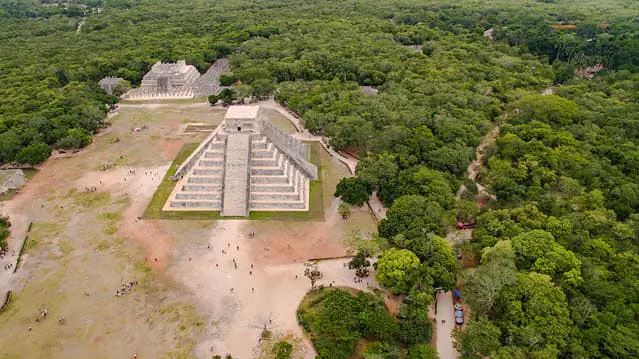
A marvel of Mayan architecture, Chichen Itza was a sacred site to the ancient people. It was also a pilgrimage site. The Sacred Cenote, a natural sinkhole, is perhaps one of its most famous attractions. Archeologists have also linked ancient Mayans who made human sacrifices to Chaac, the Mayan God of the rain.
Similarly, the ancient Mayan architects bifurcated Chichen Itza into sections and built the structure similar to the Classic Puuc style. Likewise, other historic landmarks include the iconic El Castillo or temple pyramid, a massive pyramid constructed out of stones and laden with concrete, limestone, and graphite.
According to archeologists, the Mayans constructed the pyramid to honor Kukulcan, the legendary serpent deity. The structure, opulently decorated with carved serpents, includes inscribed square pegs with a staircase that reaches the top.
Visitors of El Castillo can still notice the creep of the shadow on the serpent carvings. The slow envelope of the shadow over the serpents makes it seem like they are slithering down the structure.
9. Temple of the Inscriptions
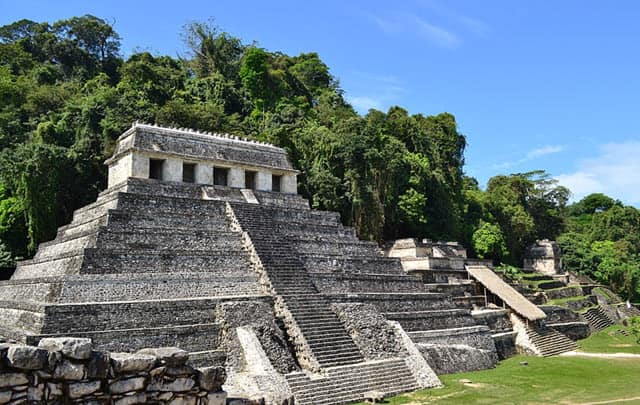
Situated at the heart of Palenque, the Temple of the Inscriptions is the largest pre-Colombian stepped pyramid in the Mexican region. Ancient Mayans constructed the pyramid to commemorate the ruler K’inich Janaab’ Pakal.
One of the best sources of knowledge on Mayan architecture and civilization, the heliographic inscriptions on the walls offer much detail about the Mayan king and what time was like during his rule.
The temple has five entrances at the front, finely carved walls, and a staircase that the builders constructed to reach the crypt inside. Archeologists have also found various tablets in the temple, which offer us immense knowledge on how the ancient Maya understood the notion of time.
8. Pyramids
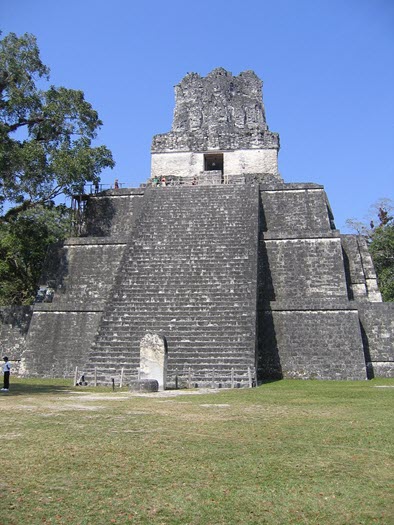
Archaeological evidence shows that by the time the Preclassic era rolled around (1000 B.C., approximately 3,000 years ago), the Mayans were already building pyramidal-plaza with ceremonial architecture. The earliest Mayan pyramidal monuments were mainly simple burial mounds, the precursors to stepped pyramids.
Furthermore, pyramids were perhaps the Maya’s most significant structures. Mayan master builders constructed the pyramids with painstakingly carved curved stones that acted as steps. These steps have rounded inset corners and chamfers around each platform.
Moreover, the ancient Mayan people often built the pyramids in dense areas of jungle and foliage where the structures could soar high above the treeline. Unlike the pyramids in Egypt, the Mayan architecture consisted of a flat top where the people often constructed temples and shrines dedicated to the Gods.
Ancient Mayan priests also used the pyramids as temples and religious meeting places. However, these pyramids were also used as tombs of deceased patrons and rulers. The dead bodies of sacrificial victims were also often buried there.
7. E-Groups
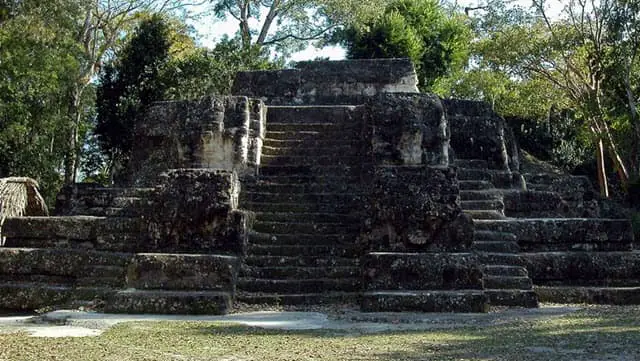
Found in several ancient Mayan settlements, E-Groups are unique architectural complexes central to Maya sites and often corresponded to the Sun’s equinox and solstice.
Like many other civic and ceremonial buildings, the ancient Maya used these E-Groups for astronomical observations.
Moreover, the ancient Maya builders mainly constructed these structures in the central and southern lowlands of the Mayan region.
Another raised and elongated platform was present on the eastern side, with a staircase to provide entry. In contrast, the thatched buildings were popular on the western side of the region.
The equinox and the solstice were critical religious events for the Maya people, and the construction of these E-Groups also coincided with the astronomical events.
Well-appointed high-ranking Mayan nobles were usually the patrons who built the E- groups with much care and enthusiasm.
6. Ball Courts
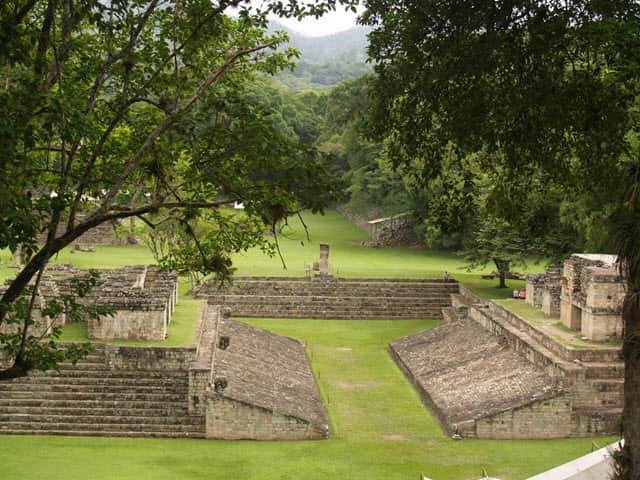
The Ball courts were large masonry structures the ancient people used in Mesoamerica over 2,700 years ago and were mostly used for playing traditional ball games by the Mesoamericans.
The ancient ball game was a variation of the high ball, which had its own ways of playing along with specific regulations and rigid rules.
For instance, the two opposing teams in the game were given a rubber ball that was required to be bounced through a high-placed ring. For so, none of the players were allowed to use either their legs or arms.
A great example of a ball game in action is portrayed in the DreamWorks movie- The Road to El Dorado.
With sloping slides, the court of the ball game hosted large spectators. The sides of the court were vertical in Uxmal and with a triple court with L-shaped walls in Tikal.
Sticking to the notion that every building in ancient times was a religious temple, and people back then did nothing but pray and hold religious ceremonies, archeologists believe these games were also religiously inclined.
The Maya built the courts following sacred nature, and players initiated the game toward the south from the north. As a popular game in Copan and continuing the grim nature of the time, the team who loses was to make certain sacrifices to the deities.
5. Temples

A prolific staple of Maya architecture, temples were quite every day for the civilization. Ancient masons built the temples using stones and constructed platforms of different shapes and sizes.
The primary purpose of temples in the Ancient Mayan Civilization was to conduct ceremonies and rituals. So, these temples were built with higher-top platforms suitable for the Mayan priests to perform the rituals.
Similarly, master builders, keeping the astronomical concepts and traditions in mind, carved the outer portion of the temples with glyphs and carvings.
Most Mayan Temples were made to distinguish using heavenly bodies such as the moon, Venus, and the sun. Even the construction work of these temples was determined by the solstices and Equinoxes, as the priests and holy men regarded them as essential periods for rituals.
4. The Pigeon House
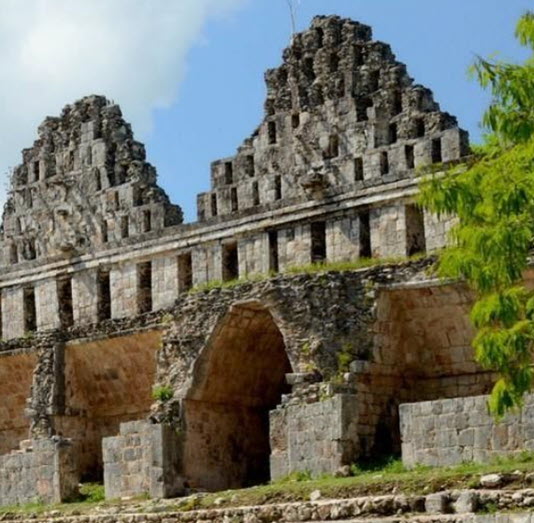
Another Mayan architecture, the Pigeon House, serving a similar motive as the temples of that region, was built for rituals and ceremonies.
The building is named so because the intricate facade resembles a dovecote with many apertures. It was built in c. 900 CE with the belief that the structure would track supernatural powers along with the heavenly bodies.
This architecture was built using limestones and rubble. And the structure’s interior and exterior walls consist of bright colored carvings and ancient paintings similar to many structures of that period.
3. Sayil Palace
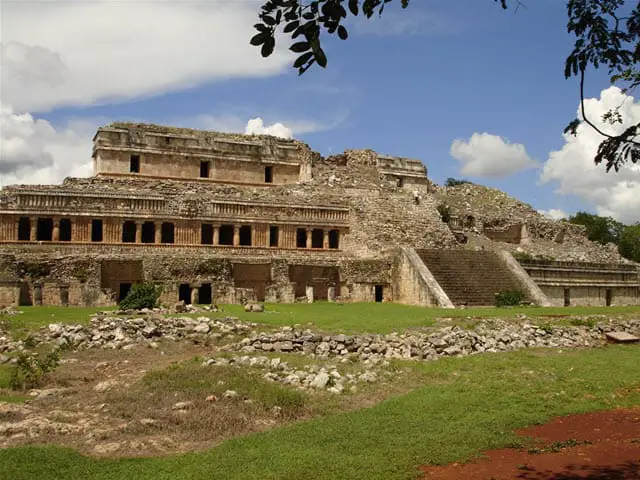
The oldest Maya architecture marvels and a UNESCO World Heritage Site, the Sayil Palace, is a three-storied building in the Yucatan. The palace’s stories have been stacked backward from each one below.
These buildings, however, were built in a side formation instead of overlapping one on top of another.
The structure used stones and concrete and was built in a unique architectural style named Puuc. El Mirador, a building within sight, is taken as an observatory.
The entire site is laid out along a sacbe, or a causeway, that runs from north to south.
The Great Sayil Palace stands at the northern end and is the largest and the most well-known building.
2. Triadic Pyramids
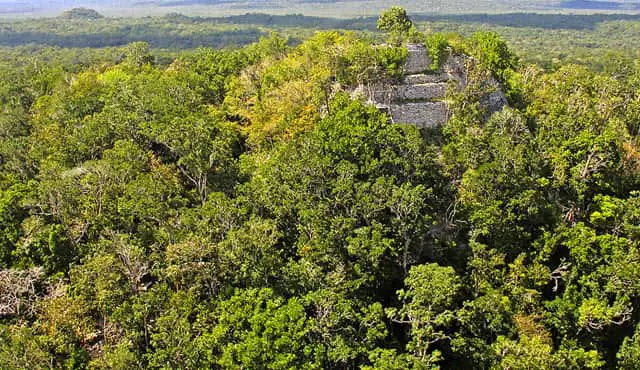
Triadic Pyramid was a unique innovation of the Mayan civilization’s pre-classic period. The pyramid was made using a structure bounded by two tiny inner-facing buildings and mounting on only one basal platform.
El Mirador in Guatemala, the biggest triadic pyramid, was built in an area almost 6 times bigger than the Tikal Temple – the biggest pyramid in the city. El Mirador has around 88 triadic pyramids.
For the most part, triadic pyramids, at present, are found at Nakbe and Peten – the early Mayan lowland cities.
1. Palaces
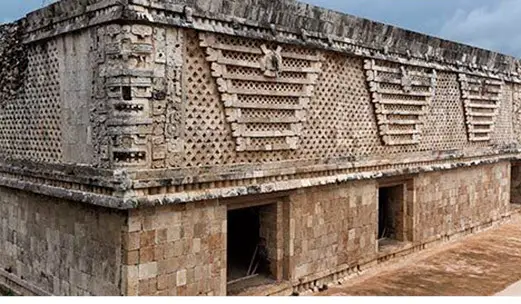
The Maya architecture was built on a grand scale and consisted of palaces as administration centers. Ancient Maya “corbelled” the palaces, an architectural style where a type of flat stone is piled up with a slight overlap to construct a narrow gap.
The corbelling ensured the structures could be topped with a single capstone. The builders also used wooden crosses to support unbalanced vaults.
The Nunnery Quadrangle in Uxmal is a prime example of this Maya architecture style. Built as a temple pyramid, the Nunnery Quadrangle’s structure originates from a traditional pattern.
The northern structure has 13 doorways, while the south has nine. Similarly, the west has seven. The ancient Maya built these doorways to represent the levels of heaven, Xibalba, and Earth, respectively.
Conclusion
Despite being extremely rich in culture, the people of the ancient Maya civilization were the epitome of master builders and experts at masonry.
Simply looking at some of the surviving buildings gives us sufficient ideation of how the civilization was all those years ago, full of life, art, and exuberance.
With very strong traditions, beliefs, and customs, Maya temples and pyramids were all built from similar materials and religious and ceremonial purposes.
